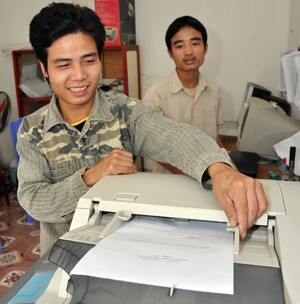
Dang Van Toan shuffled across the floor of his garage-sized shop. Flipping a switch, he warmed up his new photocopy machine against the din of heavy pounding and drilling from the metalworker next door. For years Toan hoped he would one day have his own business. With USAID training and some seed money, he has seen his dream come true in Me, Vietnam.
Me (meaning “tamarind”) is a town of 5,700 in Vietnam’s northern Ninh Binh Province. Me is home to Toan’s “Gia Vien Communal Persons with Disabilities Quality Copy Shop.” Business is good. Every day, a steady stream of district officials and students pass by to have documents typed and printed or copied. Looking back a few short years and over the obstacles he overcame, Toan could not have imagined himself to be where he is today.
Toan, 25, has diffi culty in getting around because of a disability in his right leg. A weakness in his right hand and arm also makes some tasks challenging. Growing up in a poor area, he dropped out school after ninth grade. Toan got a break when he found out about the USAID-supported Inclusion of Vietnamese with Disabilities project. Soon after signing up, he quickly showed his aptitude to learn and lead other young people with disabilities. During a nine-month computer training course, Toan earned the reputation as a fast learner and hard worker as he gained valuable skills in business office software applications. The project also provided a modest stipend, a bicycle, and life skills training including personal communications and leadership, health care, counseling, and instruction on how to start a business.
After his training, Toan worked as an apprentice at a copy shop where he was voted by his peers as the leader of a group promoting social and income-generating opportunities for people with disabilities. He convinced three other members of the group to join him in starting their own business. After securing $1,000 in seed money from the USAID project and matching this amount from their own resources, the four young people bought a photocopy machine and acquired computer equipment. Today they run the shop by themselves.
“We want to improve and expand our business, start selling offi ce supplies, and increase our income,” said Toan. “The USAID project helped all of us find jobs. It has also encouraged the public to have more open attitudes about those of us with disabilities.”







Comment
Make a general inquiry or suggest an improvement.